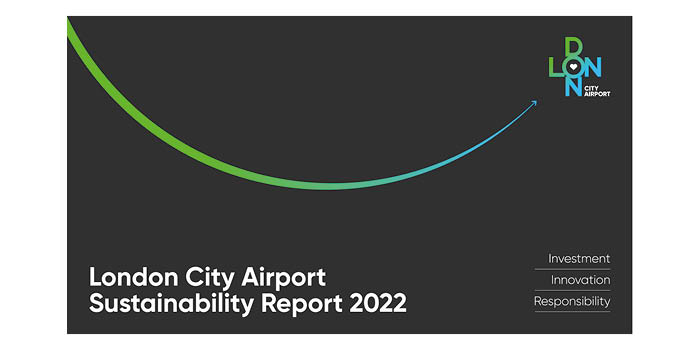London City Airport (LCY) has published its 2022 Sustainability Report, which provides updates on the airport’s progress one year on from the publication of Above and Beyond: our Roadmap to a Sustainable Future, with a quarter of the Action Plan commitments completed and over a third progressing as planned.
The report shows under the airport’s first sustainability pillar ‘Decarbonising our Airport’ that London City has made good progress in recent years in reducing the carbon emissions for which it is directly responsible (Scopes 1 and 2), and continuing to maintain its reduction in emissions in 2022, despite a significant increase in passenger numbers (which increased from 714,000 passengers in 2021 to 3,000,000 in 2022). In 2022, LCY became one of only two UK airports to achieve Level 4+ in the Airport Carbon Accreditation program.
New data found that 68% of passengers accessed the airport by public and sustainable transportation – which it states is the highest percentage of any UK airport. LCY will continue to work closely with partners to improve train and bus connections to the airport, including the new Elizabeth Line, as well as improvements to the DLR, such as the introduction of new carriages on services to the airport by 2024. The airport has also supported a car-sharing scheme for staff and rolled out in 2022 EV chargers for use by passengers, staff and taxis.
In addition, the airport has been working closely with airlines and manufacturers to certify cleaner, quieter, new-generation aircraft, including the Embraer E195-E2. The Embraer E195-E2 offers improved fuel, noise and emissions performance, benefitting airlines, passengers and the local community. This aircraft has undertaken trial flights at the airport and is expected to enter commercial operations later in 2023.
LCY has also continued to collaborate with industry partners on research to achieve zero emissions, including projects such as Project NAPKIN (New Aviation Propulsion Knowledge and Innovation Network), which has shown that London City Airport can develop the zero-emissions flying market at a meaningful scale in the next decade. This work has led to more collaboration on hydrogen pipeline projects and analysis into the delivery of SAF with organizations, such as the Thames Estuary Growth Board.
Initiatives for 2022 under LCY’s second sustainability pillar ‘Improving our Environment’ include launching the £50,000 (US$58,600) biodiversity fund to support local biodiversity projects. The airport continued to reduce waste and single-use plastics and has now eliminated single-use plastic liquids bags for security, thanks to the installation of new hi-tech CT security scanners, meaning passengers can now leave liquids and laptops in their bags at London City Airport.
The airport has made significant progress on its third sustainability pillar ‘Helping East London Grow and Prosper’ with a new staff volunteering policy that will see all staff volunteer in the local community for a minimum of eight hours a year, increasing to two days in 2024, and continuing its youth mentoring program.
The airport also reinstated its local procurement and education programs, such as its East London Meet the Buyer event, which resulted in £5.1m (US$5.9m) in contract value wins for local businesses. Additionally, the airport spent over £7m (US$8.2m) with more than 80 local businesses in 2022. The airport also saw over 700 hundred students from 24 East London schools work with aviation businesses, such as Boeing, GKN Aerospace and British Airways CityFlyer, as part of its STEM in Aviation and Women in Aviation programs. LCY points out that these initiatives are critical in supporting business, investment and jobs in its local community. In 2022, 39% of new airport recruits for London City Airport and on-site partners lived in Newham and 79% in the local area.
Robert Sinclair, CEO of London City Airport, said, “A year on from the launch of our Sustainability Roadmap, I am pleased with the progress we have made the past year across all three of our sustainability pillars. I am especially delighted that LCY has shown that, while passenger numbers increased, our overall direct emissions (Scopes 1 and 2) did not, which is an important milestone that we look forward to building on.
“The journey to achieve net-zero emissions will take time and we face similar complex, challenges as other industries around the world, including developing our future energy strategy to power our buildings and how we provide infrastructure to support our airlines with the right fuels they will need over the next decade.”
For more key sustainability updates from the passenger terminal industry, click here.

